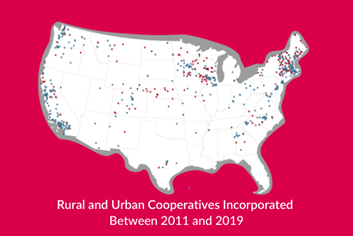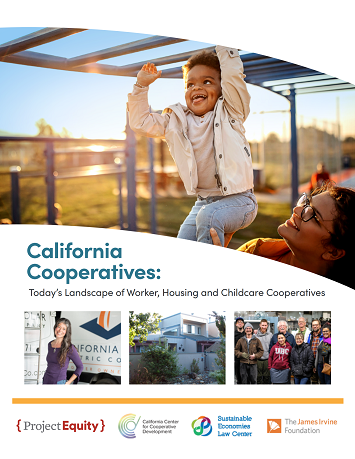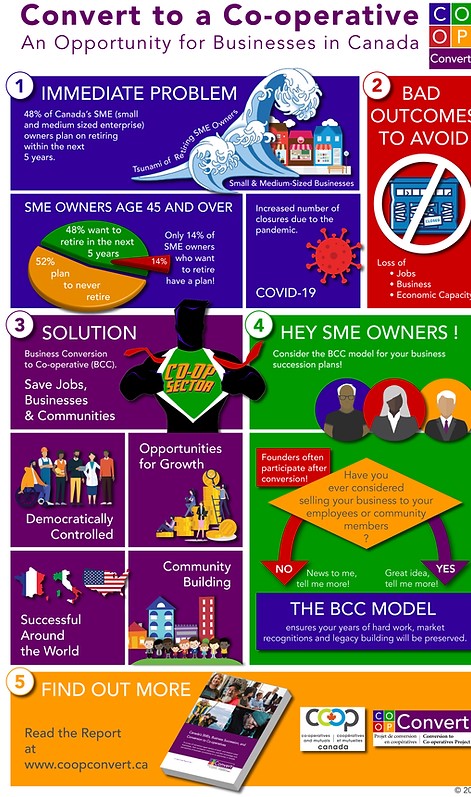New research and reports show importance of ecosystems for growing cooperative economy
by Karen Kahn
In the last six months of 2021, new reports offered insights into the prevalence of and potential for growing worker cooperatives, as a strategy for economic development.
Collective Action in Rural Communities

This report from the Center for Cooperatives at the University of Wisconsin-Madison uses data from two surveys, one from 2011-2016 and another from 2016-2019 to identify trends in the incorporation of new cooperatives and the factors influencing the growth of “cooperative clusters.”
The data analysis revealed a burst of new worker cooperatives after 2016. Over the entire period, 2011-2019, the incorporation of consumer co-ops was most common, at 36 percent. Worker co-ops followed at 27 percent. But while the incorporation of consumer cooperatives was most common (40 percent of new co-ops) during the first survey, they were surpassed by worker co-ops (47 percent of new co-ops) during the second survey, 2016-2019.
While the incorporation of consumer cooperatives was most common during the first survey, they were surpassed by worker co-ops during the second survey.
The report identifies seven factors that contribute to the evolution of regional co-op clusters. These include 1) the presence of co-op development centers or other facilitators; 2) statutory provisions or attorneys who understand the legal context; 3) co-op friendly capital; 4) co-op education for the public; 5) the presence of established co-ops; 6) policy friendly environments; and 7) connections among co-ops and with their communities. Not all of the variables need to be present, but the most robust co-op clusters emerged within supportive ecosystems.
Finally, the center has used its research to create an online National Cooperative Ecosystem Resource Map and Directory. The directory, which can be searched for national-, regional-, or state-level resources, includes the following:
- Cooperative Developers
- Cooperative Associations
- Cooperative Statutes
- Cooperative Friendly Capital
California Cooperatives: Today’s Landscape of Worker, Housing, and Child Care Cooperatives

In this report from three leading cooperative development organizations—California Center for Cooperative Development, Project Equity, and Sustainable Economies Law Center—the authors look to cooperatives as a solution to the multiple economic crises facing Californians: over-priced housing; poor job quality and low wages; and insufficient affordable childcare options. Like the UW-Madison report, the California report takes an ecosystem approach, offering a detailed picture of the current state of worker, housing, and childcare co-ops; the ecosystem institutions, policies, and relationships that support them; and what the state and municipalities can do to support growth of the cooperative model.
An estimated 100 worker co-ops employ about 1500 Californians.
The worker cooperative chapter identifies an estimated 100 active worker co-ops in California, employing 1,500 Californians, two thirds of whom are women and more than half, people of color. Notably, it finds an increase in the number of businesses converting to worker cooperatives, which has increased the average size of cooperative businesses. Among the recommendations to support the worker cooperative ecosystem and grow cooperative businesses are the following:
- Raise awareness of worker cooperatives and other forms of broad-based employee ownership among business owners, government agencies, and the business service provider community.
- Prioritize scalable and/or strategic co-op development by building co-op development capacity and investing in high-impact models.
- Engage state and local governments through programs and policies to accelerate expansion of worker cooperatives.
Though parent co-ops are the primary structure for childcare co-ops, the report recommends supporting the development of multistakeholder cooperatives, inclusive of parents and teachers, as a means of expanding childcare centers. The report is available from the California Center for Cooperative Development.
Canada’s SMEs, Business Succession, and Conversion to Co-operatives

Canada’s CoopConvert initiative has completed its final report and developed a comprehensive website with case studies of businesses that have converted to cooperatives and tools and resources for business considering a cooperative structure in their succession planning.
Much like the United States, Canada faces a silver tsunami of business closures, accelerated by COVID-19. About 48 percent of business owners report their intention to retire over the next five years, but only 14 percent report having a succession plan. As part of a government effort to encourage social enterprise conversions, a university team in partnership with several national and regional cooperative associations explored the current cooperative landscape and what factors inhibit or facilitate co-op conversions. Among their findings, about 200 businesses across Canada have converted to cooperative structures in recent years. These include a range of models: consumer, producer, worker, and multistakeholder cooperatives.
If business owners understood the strength of the cooperative model in terms of resiliency and employee retention, they would be more open to considering cooperative ownership as a potential succession solution.
The greatest barrier to cooperative conversion, the researchers found, is a lack of understanding of the cooperative model among business owners. Overwhelmingly, Canada’s owners of small- and medium-sized enterprises (SMEs) think of the model as “inefficient,” “uncompetitive,” and/or “radical.” At the same time, nearly three-quarters of business owners recognize that equity ownership improves employee loyalty. With turnover being one of the greatest challenges facing business owners today, this finding is significant. As the researchers note, if business owners understood the strength of the cooperative model in terms of resiliency and employee retention, they would be more open to considering cooperative ownership as a potential succession solution. Now, as a result of this three-year project, Canada’s business owners have greater access to the information, tools, and resources they need to explore converting their businesses to cooperatives.
Karen Kahn is a communications consultant and the editor of Employee Ownership News.
To follow Employee Ownership News, subscribe to the Fifty by Fifty newsletter or follow us on Medium.
